By Elizabeth Heffernan, RAHS Intern
On Monday 15 March 2021, thousands of protestors attended more than forty ‘March 4 Justice’ events across the country. From Melbourne to Mullumbimby, participants rallied against the virulent culture of gendered violence, harassment, and discrimination that plagues even the highest offices of federal parliament. They wore black and carried placards denouncing misogyny, domestic violence, rape culture, and sexual abuse in the workplace. Their rallying cry was simple and became a trending hashtag: #EnoughIsEnough.
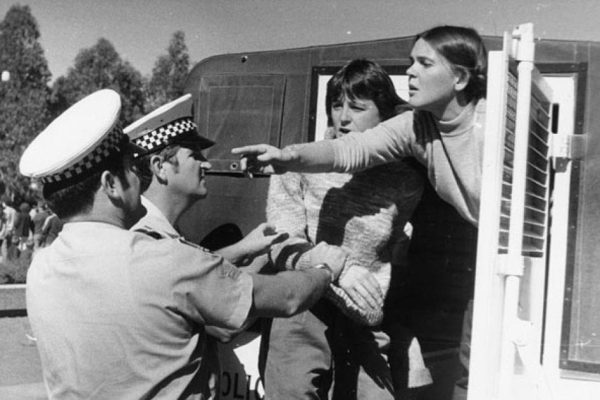
PROTESTER IN THE WOMEN AGAINST RAPE IN WAR DEMONSTRATION ON ANZAC PARADE DEMANDS TO KNOW THE NUMBER OF THE ARRESTING CONSTABLE, SYDNEY, 25 APRIL 1981. [IMAGE COURTESY GLEN MCDONALD, ACT HERITAGE LIBRARY, CANBERRA TIMES COLLECTION, 008867.]
Women’s protests have long been a vital and vibrant part of Australian history. From the turn-of-the-century suffragettes to the 2017 worldwide Women’s March, public demonstrations have proven their worth as agents of political, social, and cultural change.
It’s not just a small group of us anymore. People are educated, aware, and they’re determined. — Australian journalist Jess Hill in an interview with UTS Central News
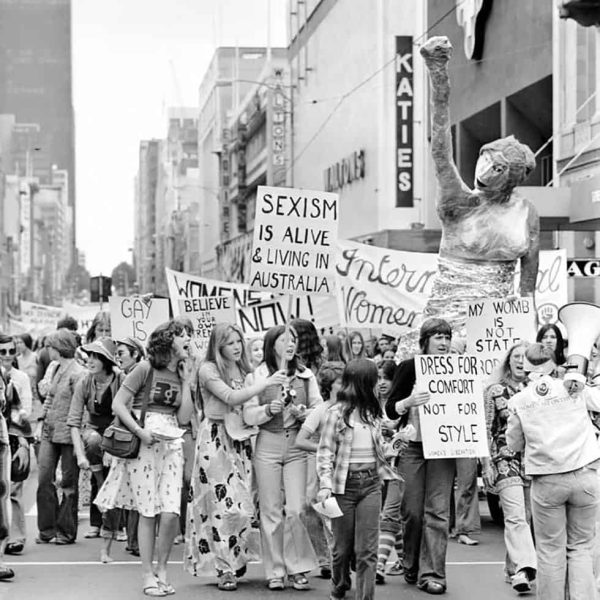
PROTESTORS AT THE FIRST INTERNATIONAL WOMEN’S DAY RALLY IN MELBOURNE, 8 MARCH 1975. [IMAGE COURTESY NATIONAL ARCHIVES OF AUSTRALIA, A6180, 19/3/75/5.]
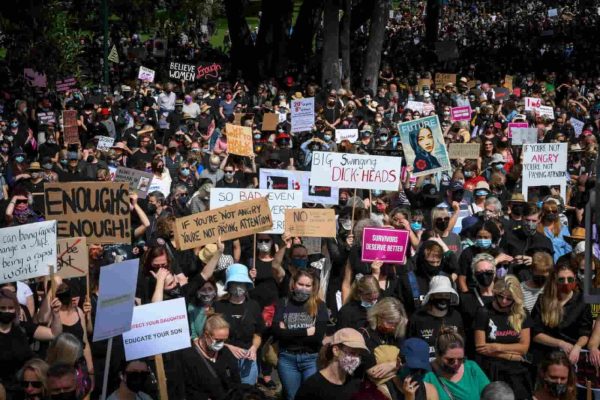
PROTESTORS AT THE MELBOURNE MARCH 4 JUSTICE, 15 MARCH 2021. [IMAGE COURTESY EDDIE JIM, SYDNEY MORNING HERALD.]
Women’s suffrage
The white, green, and violet-clad suffragette was a globally recognised icon from the mid-nineteenth century onwards. Typically a middle to upper-middle-class white woman, she campaigned tirelessly for the right to vote—a political privilege that had been reserved for white men for centuries.
In Australia, the first women’s suffrage society was established in 1884 in Victoria. Women travelled door to door across the colonies, trailing petitions and distributing pamphlets. They lobbied the government, held public debates, and marched through the streets to generate awareness and popularity for their cause. South Australia led the way, granting all women—including Aboriginal women—the right to vote and stand for election in 1894. The nation followed suit in 1902, though simultaneously barring Indigenous people of any gender from voting. The ban was lifted in 1962 after further hard-fought protests.
Australia was the second country in the world, after New Zealand, to grant women’s suffrage nation-wide. Despite these early victories, it took twenty years for the first woman to be elected to state parliament, and another twenty before women joined at the federal level. Only in 2016 did Linda Burney become the first Aboriginal woman elected to the House of Representatives.
It is difficult to imagine that 120 years ago, most women in Australia could not vote. Without the efforts of such Australian suffragettes as Vida Goldstein, Mary Lee, Catherine Helen Spence, and many more, that victory would have been even longer in the making.
Towards equality
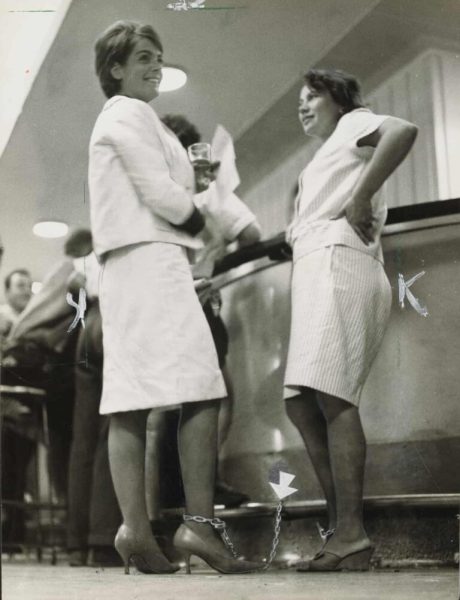
ROSALIE BOGNER (LEFT) AND MERLE THORNTON CHAINED THEMSELVES TO THE BAR OF THE REGATTA HOTEL IN BRISBANE IN 1965 TO PROTEST THE BAN ON WOMEN DRINKING IN MEN-ONLY PUBLIC BARS. [IMAGE COURTESY BRUCE POSTLE ARCHIVE, STATE LIBRARY OF VICTORIA.]
Gaining the vote was just the beginning. Australian women soon began campaigning for greater rights in both the public and private spheres, during what historian Marilyn Lake calls “the golden age” of Australian feminism.
Protests took the form of marches, sit-ins, rallies, and even street theatre performances. Issues included the gender pay gap—which still exists today—marriage, divorce, and reproductive rights; equality in the workplace; and the rights of Aboriginal and Torres Strait Islander women. Support for the women’s movement only grew after the Second World War, as more and more women who had enlisted in the Women’s Land Army sought similar freedoms in their civilian lives.
The so-called ‘Marriage Bar’ that excluded married women from the workplace was lifted in the education sector in 1956 and for public servants in 1966. Initial access to the contraceptive pill—taxed at 27.5% as a ‘luxury’, only completely repealed in 2018—was granted in 1961, with conditional abortion rights following in 1969.
The 1970s was home to the United Nations International Women’s Year in 1975, and saw great strides in equal pay, maternity leave, childcare, and divorce and marriage rights. The 70s also heralded the first International Women’s Day rally in Australia, held in Melbourne on 8 March 1975, two years before the day was officially recognised by the UN. Australia ratified the UN Convention on the Elimination of all Forms of Discrimination Against Women in 1983.
During the 1960s and 1970s, women were also vocal voices in the anti-Vietnam War moratoriums and, from the 1980s, drew attention to the gendered silences surrounding the national commemoration of Anzac Day through the Women Against Rape in War campaign. Everywhere you turn in Australian history, a woman holds her protest sign high.
‘Shatter the silence, stop the violence’
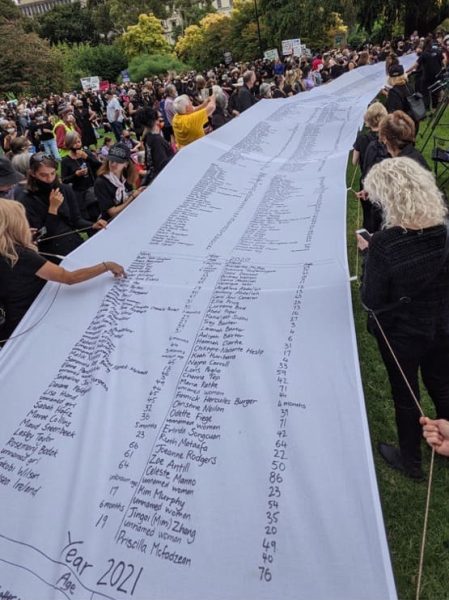
A BANNER AT MELBOURNE’S MARCH 4 JUSTICE LISTING ALL AUSTRALIAN WOMEN KILLED BY GENDERED VIOLENCE SINCE 2008. [IMAGE COURTESY ANTOUN ISSA, @ANTISSA ON TWITTER.]
Banner at Melbourne March 4 Justice listing all Australian women killed by gendered violence since 2008.
More recently, women’s protests have centred on ending sexual and domestic violence. “This isn’t new,” one protestor from Sydney’s March 4 Justice informed the camera. “It’s all the way to the top.”
One woman is killed every nine days by a current or former partner. One in six women has experienced sexual assault since the age of 15. One in two women has been sexually harassed since the age of 15. Two in five women have been sexually harassed in the workplace.
Aboriginal and Torres Strait Islander women in particular are disproportionately affected, not only by domestic and sexual violence but by institutional violence in police custody.
It is no wonder thousands of Australians marched to say enough is enough.
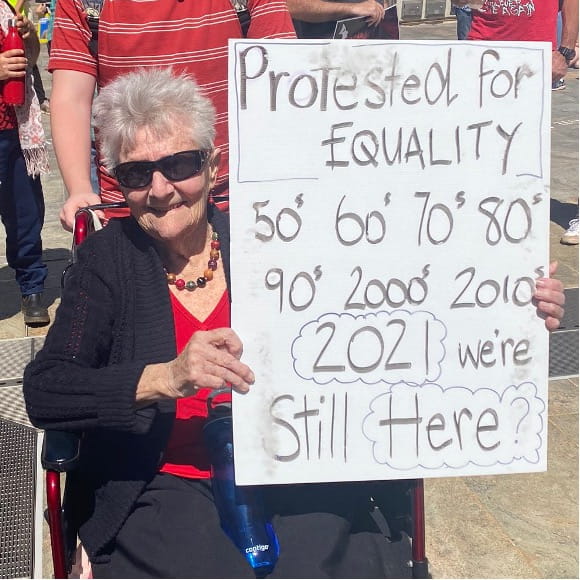
PROTESTOR AT THE PERTH MARCH 4 JUSTICE. [IMAGE COURTESY KATY THOMSON, @DMCKATEFACE ON TWITTER.]
Protests throughout Australian history have long been forces for powerful change. Women would not have the vote, and all our legal rights since, without them. These recent demonstrations are no different. It may be bleak to consider how much work still needs to be done to secure respect, safety, and equality for people of all genders, races, sexualities, and backgrounds. As one sign from Perth’s March 4 Justice put it:
Yet so long as there are protests, there are things worth protesting, and people worth protesting for.
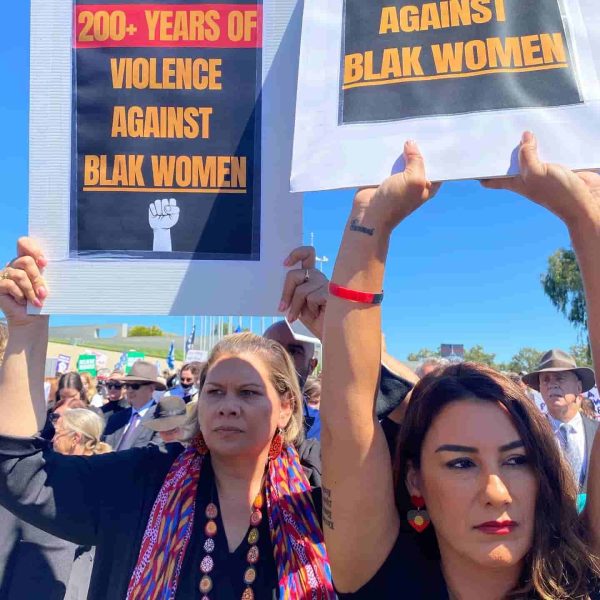
SENATOR LIDIA THORPE (RIGHT) PROTESTING AT CANBERRA’S MARCH 4 JUSTICE. [IMAGE COURTESY LIDIA THORPE, @LIDIA__THORPE ON TWITTER.]
References:
‘Chained to the bar’, State Library of Victoria, accessed 23 March 2021.
‘Family, domestic and sexual violence in Australia: continuing the national story 2019’, 5 June 2019, Australian Institute of Health and Welfare, https://www.aihw.gov.au/reports/domestic-violence/family-domestic-sexual-violence-australia-2019/contents/summary.
‘Gender Equality Timeline’, Victorian Women’s Trust, https://www.vwt.org.au/gender-equality-timeline-australia/, accessed 22 March 2021.
‘Sexual assault in Australia’, 28 August 2020, Australian Institute of Health and Welfare, https://www.aihw.gov.au/reports/domestic-violence/sexual-assault-in-australia/contents/summary.
‘The Suffragettes’, Rosie, https://rosie.org.au/our-world/womens-rights/the-suffragettes/, accessed 22 March 2021.
‘Thousands gather in the Sydney March 4 Justice 2021 | “Enough is enough!”’, Central News UTS, 15 March 2021, https://www.youtube.com/watch?v=siFFKYiPqJY.
‘Women’s Suffrage’, National Library of Australia, https://www.library.gov.au/learn/digital-classroom/feminism-australia/womens-suffrage, accessed 22 March 2021.
Barbara Caine, ‘Australian Feminism and the British Militant Suffragettes’, Papers on Parliament No. 41, June 2004, Parliament of Australia, https://www.aph.gov.au/About_Parliament/Senate/Powers_practice_n_procedures/~/~/link.aspx?_id=3C44655A04494661A14BF77C89E93438&_z=z.
Helen Jones, ‘Lee, Mary (1821-1909)’, Australian Dictionary of Biography, National Centre of Biography, Australian National University, https://adb.anu.edu.au/biography/lee-mary-7150, accessed 23 March 2021.
Janice N. Brownfoot, ‘Goldstein, Vida Jane (1869-1949)’, Australian Dictionary of Biography, National Centre of Biography, Australian National University, https://adb.anu.edu.au/biography/goldstein-vida-jane-6418, accessed 23 March 2021.
Marilyn Lake, Getting Equal: the History of Australian Feminism (St Leonards, NSW: Allen & Unwin, 1999).
Meredith Burgmann, ‘The forgotten Anzac Day protests of the ’80s’, Crikey, 24 April 2018, https://www.crikey.com.au/2018/04/24/the-forgotten-anzac-day-protests-of-the-80s/.
Susan Eade, ‘Spence, Catherine Helen (1825-1910)’, Australian Dictionary of Biography, National Centre of Biography, Australian National University, https://adb.anu.edu.au/biography/spence-catherine-helen-4627, accessed 23 March 2021.
Verity Burgmann and Sean Scalmer, ‘Protest!’, University of Melbourne, https://archives.unimelb.edu.au/explore/exhibitions/past-events/protest!-archives-from-the-university-of-melbourne/protest!, accessed 23 March 2021.
Wendy Squires, ‘These events are seared on my heart: Women, equality, and the long march to progress’, Sydney Morning Herald, 19 March 2021, https://www.smh.com.au/national/these-events-are-seared-on-my-heart-women-equality-and-the-long-march-to-progress-20210319-p57c6c.html.

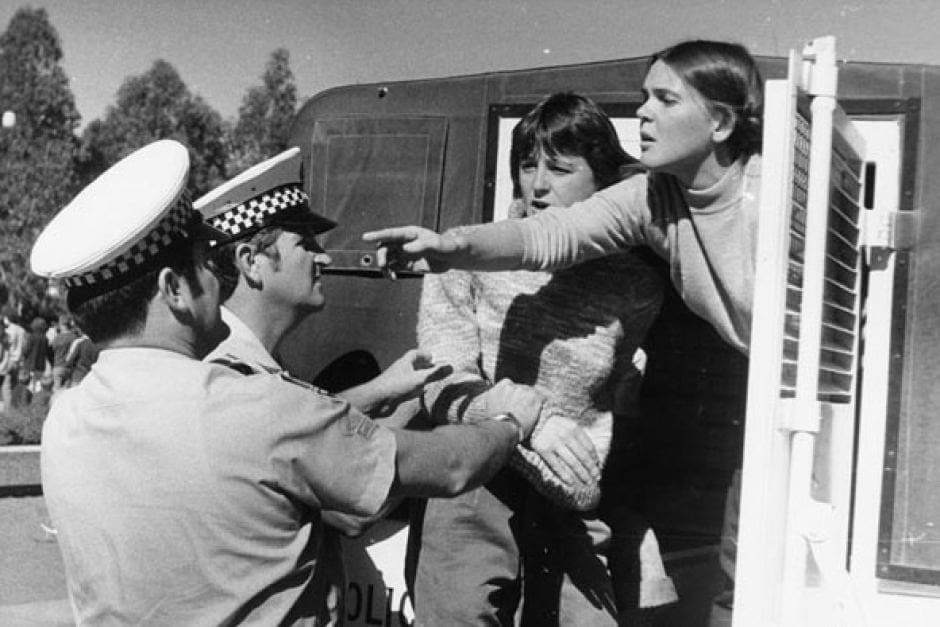
0 Comments